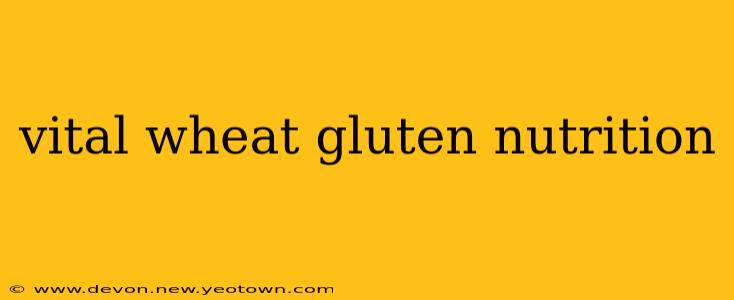Vital wheat gluten, a powerhouse of protein derived from wheat flour, often takes a backseat in the spotlight compared to other nutritional superstars. But this unassuming ingredient is a nutritional heavyweight, especially for those seeking a plant-based protein boost or aiming for specific dietary goals. Let's unravel the nutritional profile of vital wheat gluten and explore its potential benefits and considerations.
Imagine a bustling kitchen, flour dust dancing in the air, the aroma of freshly baked bread filling the room. That's where our story begins, with the humble wheat kernel. Within this kernel lies a protein network—gluten—responsible for the elasticity and chewiness of bread and pasta. Vital wheat gluten is the concentrated form of this protein, extracted to create a pure, gluten-rich powder.
What is Vital Wheat Gluten?
Vital wheat gluten is essentially the protein component of wheat, stripped of the starch. This process yields a product that's around 75-85% protein, making it an excellent source of plant-based protein. It's a versatile ingredient used in meat substitutes, baked goods, and other food products to enhance texture and protein content.
Vital Wheat Gluten Nutrition Facts
A typical serving (100g) of vital wheat gluten boasts a significant protein content. This high protein concentration is its primary claim to fame. But what about other nutrients? While not a rich source of vitamins and minerals like some fruits and vegetables, vital wheat gluten provides some essential elements:
- High in Protein: This is the star of the show, offering a substantial amount of protein per serving.
- Good Source of Fiber: Though the fiber content isn't as high as some whole grains, it still contributes to digestive health.
- Low in Fat: Vital wheat gluten is relatively low in fat, making it a suitable choice for those watching their fat intake.
- Carbohydrate Content: It does contain carbohydrates, primarily from the residual starch present after the extraction process.
(Specific nutrient values can vary depending on the brand and processing methods.)
How Much Protein is in Vital Wheat Gluten?
This is arguably the most frequently asked question about vital wheat gluten. As mentioned earlier, it contains a very high concentration of protein—around 75-85% by weight. This makes it a valuable addition to the diets of vegetarians, vegans, and anyone looking to increase their daily protein intake. This protein content contributes significantly to satiety, helping you feel full for longer.
Is Vital Wheat Gluten Gluten-Free?
This is a crucial question for those with celiac disease or gluten sensitivity. The answer is a resounding no. Vital wheat gluten is, by definition, pure gluten. Therefore, it's strictly off-limits for individuals on a gluten-free diet.
What are the Health Benefits of Vital Wheat Gluten?
The primary health benefit of vital wheat gluten lies in its high protein content. Protein is crucial for building and repairing tissues, supporting immune function, and providing energy. For vegetarians and vegans, it offers a readily available source of complete protein (meaning it contains all essential amino acids).
Additionally, the fiber present contributes to healthy digestion and can promote regularity.
What are the Potential Side Effects of Vital Wheat Gluten?
While generally safe for consumption, vital wheat gluten can have some potential drawbacks:
- Digestive Issues: For some individuals, particularly those with sensitivities, it might lead to digestive discomfort such as bloating, gas, or constipation.
- Celiac Disease/Gluten Sensitivity: As emphasized earlier, individuals with celiac disease or gluten sensitivity must strictly avoid vital wheat gluten.
How to Incorporate Vital Wheat Gluten into Your Diet?
Vital wheat gluten's versatility shines through in its culinary applications. It's commonly used in:
- Meat Substitutes: Its ability to bind and create a meaty texture makes it an excellent ingredient in vegan burgers, sausages, and other meatless options.
- Baked Goods: It can improve the texture and chewiness of bread, pasta, and other baked goods.
- Seitan: This popular vegan meat alternative is almost entirely made from vital wheat gluten.
This deep dive into the world of vital wheat gluten highlights its unique nutritional profile and versatile applications. Remember to consider your individual dietary needs and consult a healthcare professional or registered dietitian before making significant changes to your diet.

